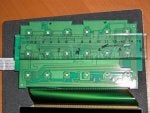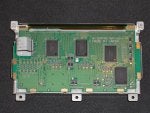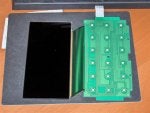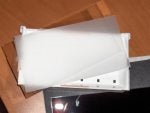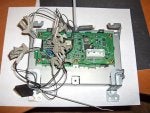I need to connect my logic analyser to mine to capture the data to the display during start up, and I hope to do this this weekend. So while I'm at it, I'll take a look at where the LEDs are and what size.
The black plastic cover on the back of the display, is just held in by little tabs. Once you remove this, you see:
Where the white ribbon cable attaches on the left, can be released. Part of the black connector is pushed in to compress the end of the cable. You can release this by gently pulling up on the edge of it, either side. It will come up a bit, but not out, and then you can pull out the ribbon cable and remove the screws holding in the circuit board. This board is the one that takes the data sent to the display unit and formats into the bits to turn on and off each segment or indicator in the display itself.
The next step is to unscrew the metal case from the display. There's a black plastic cover on the front of the display, that also has little tabs that hold it in place. Make a note of which way it's on, so you put it back on the right way around. It will fit upside down, but then the clear opening on the front will be a little off in position.
Once you have the display out of all this, it will look like this.
The next step, which I have yet to do, because I had no need to, is to straighten out the metal tabs that hold the display in place, and then being extremely, did I say extremely, careful, lift the PC board from the carrier, ensuring the connector to the LCD itself is not stressed or damaged in any way. Damage that, and you just trashed your display. I expect there are surface mount LEDs on the other side,but I've not taken mine apart to see where, how many and what size.
Yet.
One note about this whole process... You must do this in an environment that is low static. Don't do it on a plastic surface, try not to drag your feet across the carpet before doing this, don't play with your Van der Graf generator or Tesla coil, immediately before and try to handle the circuit boards by the mounting points (screw holes, tab pads) when you first touch it each time.
Static electricity can cook a part and you'll never know it happened. Well, until you try to use it again.


